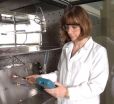(Press-News.org) For worms, choosing when to search for a new dinner spot depends on many factors, both internal and external: how hungry they are, for example, how much oxygen is in the air, and how many other worms are around. A new study demonstrates this all-important decision is also influenced by the worm's genetic make-up.
In the simple Caenorhabditis elegans nematode, the researchers found that natural variations in several genes influence how quickly a worm will leave a lawn of bacteria on which it's feeding. One of the genes, called tyra-3, produces a receptor activated by adrenaline—a chemical messenger involved in the 'fight-or-flight' response. The findings appeared online March 16, 2011, in the journal Nature.
"What's encouraging to us about this story is that molecules related to adrenaline are implicated in arousal systems and in decision-making across a lot of different animals, including humans," says Howard Hughes Medical Institute investigator Cornelia Bargmann of Rockefeller University in New York, who mentored the work of graduate student Andres Bendesky. These parallels between diverse species suggest that aspects of our decision-making abilities have ancient evolutionary roots.
Six worms on a small lawn of bacterial food (circle). Occasionally, a worm leaves the food to explore the surrounding environment.
Video: Bendesky et al. Nature
C. elegans thrive in agricultural settings, such as orchards and crop lands, feeding on bacteria from rotting fruits and vegetables. But eating in this environment is tricky: the worms encounter many bacterial species that are difficult to digest or even toxic. "The worms need to somehow evaluate a whole spectrum of conditions to decide whether they want to try this food source or go out and look for a better one," Bargmann says.
The great scientific advantage of using C. elegans to study complicated behavioral processes such as decision-making is that the worms have only 302 neurons, and the connections between all those neurons have all been precisely mapped. In contrast, the human brain has billions of neurons. What's more, most of the worm's 20,000 genes have equivalents in the human genome. "Behavior includes the action of genes, their function in neurons, and the neurons' assembly into circuits," Bargmann says. "Studying C. elegans gives you an exceptional ability to make connections between those levels."
Over the past decade, her lab has probed several of these levels. In 2004, they reported that C. elegans sense precise oxygen concentrations in soil, which helps steer them toward their favorite meal: oxygen-consuming bacteria. Three years later, they investigated what neurons do with chemosensory information, finding that odor-sensing neurons can switch on other cells that control crawling and turning behaviors.
In the new study, Bendesky and Bargmann went one level deeper, investigating how genetic tweaks can change a worm's behavior in particular circumstances. To do their experiments, the researchers placed hundreds of different strains of C. elegans onto Petri dishes lined with a circular "lawn" of bacteria and calculated the rate at which worms left the lawn. "Lawn-leaving is something that occurs abruptly, in an all-or-none way. It's very striking," Bargmann says.
To find the genes that affect the behavior, they collaborated with HHMI investigator Leonid Kruglyak and his postdoc Matt Rockman to use a technique called quantitative trait locus analysis, they then analyzed the precise genetic make-up of each strain and correlated it with how frequently each strain left its lawn. In the end, the researchers could pinpoint particular genetic blips associated with moving away from a food source.
One of those blips crops up in a gene called npr-1, which had already been associated with foraging behaviors and immunity in the worm. The npr-1 variant is a special case, however, because it evolved in laboratory strains of C. elegans and is not known to exist in the wild.
In a more exciting development, the researchers also found a natural genetic variation in tyra-3 that is associated with lawn-leaving. This gene encodes a receptor protein that responds to tyramine, an adrenaline–like hormones derived from the amino acid tyrosine. Like adrenaline, tyramine is an internal signal that regulates the function of neurons expressing its various receptors.
To find out where in the brain the tyra-3 gene is turned on, the researchers engineered strains of worms in which they could observe production of tyra-3. By attaching a fluorescent green marker to the tyra-3 protein, they could easily observe whenever the protein was made. They then traced where the green fluorescence appeared inside the worms and discovered that the tyra-3 receptor is produced in a place that makes intuitive sense: sensory neurons. In these neurons, external cues, such as oxygen levels, can be integrated with internal states, such as hunger. "It's the result you would have gotten if you made it up," Bargmann says, laughing.
The findings show that particular genetic variants lead to specific behaviors in the real world—but how, exactly, they do this is still mysterious. "We don't have a fix on when tyramine is being made, where it's released, and how it's working to change behavior," Bargmann says.
Figuring that out is the obvious next step. The trouble is, the tools for tracking the brain's chemical messengers in real time don't exist yet. "We'll just have to put our heads down and develop some," she says.
### END
Dine or dash? Genes help decide when to look for new food
2011-03-18
ELSE PRESS RELEASES FROM THIS DATE:
Rare Andean cat no longer exclusive to the Andes
2011-03-18
Once thought to exclusively inhabit its namesake mountain range, the threatened Andean cat—a house cat-sized feline that resembles a small snow leopard in both appearance and habitat—also frequents the Patagonian steppe at much lower elevations, according to a new study published by the Wildlife Conservation Society and partners.
The finding represents a range extension for the Andean cat, which normally occurs at altitudes above 3,000 meters (approximately 9,800 feet). The new survey presents evidence of the cats occurring at elevations as low as 650 meters (approximately ...
Paleontologists audition modern examples of ancient behavior
2011-03-18
Paleontologists agree that it's difficult to observe behavior in fossil specimens that are dead – even extinct – and petrified. One method is to find a modern, living, species that has some similarities to the ancient animal.
That's the strategy adopted by David L. Meyer, University of Cincinnati professor of geology and colleagues as they study a group of ancient shellfish known as brachiopods. Although they resemble clams or other shelled mollusks, brachiopods are more closely related to marine worms. Relatively rare today, brachiopods were a dominant species in Paleozoic ...
Pardee Homes' Manzanita Trail in Coastal-close North San Diego County Offers Options for Downsizing
2011-03-18
Home shoppers who want the bigger bedroom count, but not the responsibilities of a big yard, have two great choices at Pardee Homes' Manzanita Trail in Pacific Highlands Ranch. The classic front porch designed Plan 1 and Plan 2 homes each have four bedrooms and very manageable side courtyards that help free the homeowner from yard work. Residents at Manzanita Trail also enjoy all the benefits of living within walking distance to the private Pacific Highlands Ranch Recreation Center.
Families like the McSherrys, who have four children, were thrilled to downsize from their ...
Breaking the mucus barrier unveils cancer cell secrets
2011-03-18
Washington, D.C. (March 16, 2011) -- Measuring the mechanical strength of cancer cell mucus layers provides clues about better ways to treat cancer, and also suggests why some cancer cells are more resistant to drugs than others, according to Kai-tak Wan, associate professor of engineering at Northeastern University, Boston, Mass.
According to Wan, healthy tissues naturally secrete mucus to protect against infection. Cancer cells, however, produce far more mucus than healthy cells.
Mucus consists of protein "stalks" attached to sugar sidechains, or "branches." This ...
Bacterial wipes research study
2011-03-18
(Edmonton) If you have time to quickly swipe your pager or cell phone three times, that would be your best bet to get rid of most of the bacteria. And a simple tissue moistened with saline would do the trick. But if you only have time for a single swipe of a 'dirty' phone – you'd be better off reaching for a disinfectant wipe.
Those are the highlights of a recently published research study that appeared online in PubMed, with the discoveries having been made by a team of researchers in the Faculty of Medicine & Dentistry at the University of Alberta.
"It was the mechanical ...
Fossils record ancient migrations and trilobite orgies
2011-03-18
Few specimens inspire greater thrills among fossil collectors than a complete trilobite. These ancient arthropods – relatives of lobsters, spiders and insects – went extinct more than 250 million years ago, but are sometimes found in beautifully preserved condition. In rare instances, an entire population of trilobites is found fossilized together. Carlton E. Brett finds evidence for ancient environment and behavior in these mass graves.
Brett, University of Cincinnati professor of geology, will present his findings March 20 at the Geological Society of America regional ...
New tool debuts for measuring indoor air pollutants
2011-03-18
A promising new approach for checking the accuracy of measurements of hazardous indoor air pollutants may soon be ready for prime time, report researchers from the National Institute of Standards and Technology (NIST) and Virginia Tech.* The measurement tool, a reference sample for volatile organic compounds (VOCs), would be a boon to testers of indoor air quality and to manufacturers of paints, rugs, cleaners and other building products.
The researchers put their innovation—thin squares of plastic saturated with vapors of a common solvent—through the paces at four testing ...
New NIST testing device may help to 'seal the deal' for building owners
2011-03-18
Just as a chain is as strong as its weakest link, a building is as secure against the environment as its most degraded joint sealants, about 50 percent of which fail in less than 10 years after installation.
The upshot for U.S. homeowners is that moisture damage due to failed sealants is responsible for much of the $65 billion to $80 billion they collectively shell out for house repairs annually.
Researchers at the National Institute of Standards and Technology (NIST) are assembling a toolkit of measurement devices and scientific data that will help manufacturers of ...
Study shows attendance at state parks grows, even as funding decreases
2011-03-18
A recent study from North Carolina State University shows that while the number of visits to state parks across the country has grown, fund support for park operations has been significantly reduced. The reduction in funding during a time of park growth endangers the more than $20 billion in economic impact that state parks have on the nation's economy.
"Obviously the reduction in general-fund support for operations puts stress on America's state-park systems," says Dr. Yu-Fai Leung, NC State associate professor of recreation ecology, park planning and visitor management, ...
3 in 4 domestic violence victims go unidentified in emergency rooms, Penn study shows
2011-03-18
PHILADELPHIA -- More than three quarters of domestic violence victims who report the incidents to police seek health care in emergency rooms, but most of them are never identified as being victims of abuse during their hospital visit. These findings, from a new University of Pennsylvania School of Medicine study, point to a missed opportunity to intervene and offer help to women who suffer violence at the hands of an intimate partner.
"Emergency departments are a safety net for women with health issues of all kinds, but our study shows we're not doing a good enough job ...



